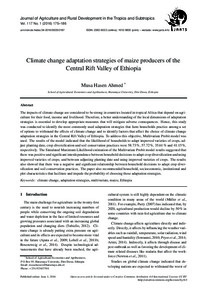| dc.date.accessioned | 2016-06-13T08:43:18Z | |
| dc.date.available | 2016-06-13T08:43:18Z | |
| dc.date.issued | 2016-06-01 | |
| dc.identifier.issn | 1612-9830 | |
| dc.identifier.issn | 2363-6033 | |
| dc.identifier.uri | urn:nbn:de:hebis:34-2016050350187 | |
| dc.identifier.uri | http://hdl.handle.net/123456789/2016050350187 | |
| dc.language.iso | eng | |
| dc.publisher | Kassel University Press | ger |
| dc.rights | Urheberrechtlich geschützt | |
| dc.rights.uri | https://rightsstatements.org/page/InC/1.0/ | |
| dc.subject | climate change | eng |
| dc.subject | adaptation strategies | eng |
| dc.subject | multivariate | eng |
| dc.subject | maize | eng |
| dc.subject | Ethiopia | eng |
| dc.subject.ddc | 630 | |
| dc.title | Climate change adaptation strategies of maize producers of the Central Rift Valley of Ethiopia | eng |
| dc.type | Aufsatz | |
| dcterms.abstract | The impacts of climate change are considered to be strong in countries located in tropical Africa that depend on agriculture for their food, income and livelihood. Therefore, a better understanding of the local dimensions of adaptation strategies is essential to develop appropriate measures that will mitigate adverse consequences. Hence, this study was conducted to identify the most commonly used adaptation strategies that farm households practice among a set of options to withstand the effects of climate change and to identify factors that affect the choice of climate change adaptation strategies in the Central Rift Valley of Ethiopia. To address this objective, Multivariate Probit model was used. The results of the model indicated that the likelihood of households to adapt improved varieties of crops, adjust planting date, crop diversification and soil conservation practices were 58.73%, 57.72%, 35.61% and 41.15%, respectively. The Simulated Maximum Likelihood estimation of the Multivariate Probit model results suggested that there was positive and significant interdependence between household decisions to adapt crop diversification and using improved varieties of crops; and between adjusting planting date and using improved varieties of crops. The results also showed that there was a negative and significant relationship between household decisions to adapt crop diversification and soil conservation practices. The paper also recommended household, socioeconomic, institutional and plot characteristics that facilitate and impede the probability of choosing those adaptation strategies. | eng |
| dcterms.accessRights | open access | |
| dcterms.bibliographicCitation | In: Journal of Agriculture and Rural Development in the Tropics and Subtropics. Kassel : Kassel University Press. - Vol. 117, No. 1 (2016), S. 175-186 | |
| dcterms.creator | Ahmed, Musa Hasen | |
| dc.description.everything | Gedruckte Ausg. im Verlag Kassel Univ. Press (www.upress.uni-kassel.de) erschienen. | ger |

